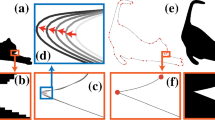Abstract
In this paper, we present a method for correcting a skeleton-based vectorization. The method robustly segments the skeleton of an image into basic features, and uses these features to reconstruct analytically all the junctions. It corrects some of the topological errors usually brought by polygonal approximation methods, and improves the precision of the junction points detection.
We first give some reminders on vectorization and explain what a good vectorization is supposed to be. We also explain the advantages and drawbacks of using skeletons. We then explain in detail our correction method, and show results on cases known to be problematic.
Access this chapter
Tax calculation will be finalised at checkout
Purchases are for personal use only
Preview
Unable to display preview. Download preview PDF.
Similar content being viewed by others
References
G. Sanniti di Baja. Well-Shaped, Stable, and Reversible Skeletons from the (3,4)-Distance Transform. Journal of Visual Communication and Image Representation, 5(1):107–115, 1994.
Ph. Dosch, G. Masini, and K. Tombre. Improving Arc Detection in Graphics Recognition. In Proceedings of 15th International Conference on Pattern Recognition, Barcelona (Spain), volume 2, pages 243–246, September 2000.
Martin A. Fischler and Robert C. Bolles. Random Sample Consensus: A Paradigm Model Fitting with Applications to Image Analysis and Automated Cartography. Communications of the ACM, 24(6):381–395, 1981.
J. Illingworth and J. Kittler. A survey of the Hough transform. Computer Vision, Graphics and Image Processing, 44:87–116, 1988.
P. L. Rosin and G. A. West. Segmentation of Edges into Lines and Arcs. Image and Vision Computing, 7(2):109–114, May 1989.
K. Tombre, C. Ah-Soon, Ph. Dosch, A. Habed, and G. Masini. Stable, Robust and Off-the-Shelf Methods for Graphics Recognition. In Proceedings of 14th International Conference on Pattern Recognition, Brisbane, Australia, pages 406–408, August 1998.
K. Tombre, Ch. Ah-Soon, Ph. Dosch, G. Masini, and S. Tabbone. Stable and Robust Vectorization: How to Make the Right Choices. In A.K. Chhabra and D. Dori, editors, Graphics Recognition-Recent Advances, volume 1941 of Lecture Notes in Computer Science, pages 3–18. Springer Verlag, 2000.
Aimo Törn and Antanas Žilinskas. Global Optimization, volume 350 of Lecture Notes in Computer Science. Springer-Verlag, Berlin, 1989.
K. Wall and P. Danielsson. A Fast Sequential Method for Polygonal Approximation of Digiti zed Curves. Computer Vision, Graphics and Image Processing, 28:220–227, 1984.
Author information
Authors and Affiliations
Editor information
Editors and Affiliations
Rights and permissions
Copyright information
© 2002 Springer-Verlag Berlin Heidelberg
About this paper
Cite this paper
Hilaire, X., Tombre, K. (2002). Improving the Accuracy of Skeleton-Based Vectorization. In: Blostein, D., Kwon, YB. (eds) Graphics Recognition Algorithms and Applications. GREC 2001. Lecture Notes in Computer Science, vol 2390. Springer, Berlin, Heidelberg. https://doi.org/10.1007/3-540-45868-9_24
Download citation
DOI: https://doi.org/10.1007/3-540-45868-9_24
Published:
Publisher Name: Springer, Berlin, Heidelberg
Print ISBN: 978-3-540-44066-6
Online ISBN: 978-3-540-45868-5
eBook Packages: Springer Book Archive




